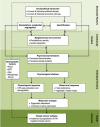Black-White Disparities in Breast Cancer Subtype: The Intersection of Socially Patterned Stress and Genetic Expression
- PMID: 29333472
- PMCID: PMC5764177
- DOI: 10.3934/publichealth.2017.5.526
Black-White Disparities in Breast Cancer Subtype: The Intersection of Socially Patterned Stress and Genetic Expression
Abstract
Hormone receptor negative (HR-) breast cancer subtypes are etiologically distinct from the more common, less aggressive, and more treatable form of estrogen receptor positive (ER+) breast cancer. Numerous population-based studies have found that, in the United States, Black women are 2 to 3 times more likely to develop HR- breast cancer than White women. Much of the existing research on racial disparities in breast cancer subtype has focused on identifying predisposing genetic factors associated with African ancestry. This approach fails to acknowledge that racial stratification shapes a wide range of environmental and social exposures over the life course. Human stress genomics considers the role of individual stress perceptions on gene expression. Yet, the role of structurally rooted biopsychosocial processes that may be activated by the social patterning of stressors in an historically unequal society, whether perceived by individual black women or not, could also impact cellular physiology and gene expression patterns relevant to HR- breast cancer etiology. Using the weathering hypothesis as our conceptual framework, we develop a structural perspective for examining racial disparities in breast cancer subtypes, integrating important findings from the stress biology, breast cancer epidemiology, and health disparities literatures. After integrating key findings from these largely independent literatures, we develop a theoretically and empirically guided framework for assessing potential multilevel factors relevant to the development of HR- breast cancer disproportionately among Black women in the US. We hypothesize that a dynamic interplay among socially patterned psychosocial stressors, physiological & behavioral responses, and genomic pathways contribute to the increased risk of HR- breast cancer among Black women. This work provides a basis for exploring potential alternative pathways linking the lived experience of race to the risk of HR- breast cancer, and suggests new avenues for research and public health action.
Keywords: breast cancer; health disparities; social environment; social genomics; weathering.
Conflict of interest statement
Conflict of Interest All authors declare no conflicts of interest in this paper.
Figures

Similar articles
-
Racial Disparity in Quadruple Negative Breast Cancer: Aggressive Biology and Potential Therapeutic Targeting and Prevention.Cancers (Basel). 2022 Sep 16;14(18):4484. doi: 10.3390/cancers14184484. Cancers (Basel). 2022. PMID: 36139643 Free PMC article. Review.
-
Breast cancer staging by subtype in the Lower Mississippi Delta region States.Cancer Epidemiol. 2019 Dec;63:101624. doi: 10.1016/j.canep.2019.101624. Epub 2019 Nov 1. Cancer Epidemiol. 2019. PMID: 31678815
-
Epigenetic Determinants of Racial Disparity in Breast Cancer: Looking beyond Genetic Alterations.Cancers (Basel). 2022 Apr 9;14(8):1903. doi: 10.3390/cancers14081903. Cancers (Basel). 2022. PMID: 35454810 Free PMC article. Review.
-
Black Feminist Thought: A Paradigm to Examine Breast Cancer Disparities.Nurs Res. 2020 Jul/Aug;69(4):272-279. doi: 10.1097/NNR.0000000000000426. Nurs Res. 2020. PMID: 32040048
-
Advancing a multilevel framework for epidemiologic research on asthma disparities.Chest. 2007 Nov;132(5 Suppl):757S-769S. doi: 10.1378/chest.07-1904. Chest. 2007. PMID: 17998340 Review.
Cited by
-
Biological Basis of Breast Cancer-Related Disparities in Precision Oncology Era.Int J Mol Sci. 2024 Apr 8;25(7):4113. doi: 10.3390/ijms25074113. Int J Mol Sci. 2024. PMID: 38612922 Free PMC article. Review.
-
Cancer Epidemiology in Hispanic Populations: What Have We Learned and Where Do We Need to Make Progress?Cancer Epidemiol Biomarkers Prev. 2022 May 4;31(5):932-941. doi: 10.1158/1055-9965.EPI-21-1303. Cancer Epidemiol Biomarkers Prev. 2022. PMID: 35247883 Free PMC article. Review.
-
Relationship Between Accelerated Biological Aging, Race, Perceived Discrimination, and Limitations in Activities of Daily Living.Int J Geriatr Gerontol. 2025;9(1):199. doi: 10.29011/2577-0748.100099. Epub 2025 Jan 31. Int J Geriatr Gerontol. 2025. PMID: 40134766 Free PMC article.
-
Purposeful surgical delay and the coronavirus pandemic: how will black breast cancer patients fare?Breast Cancer Res Treat. 2020 Aug;182(3):527-530. doi: 10.1007/s10549-020-05740-0. Epub 2020 Jun 16. Breast Cancer Res Treat. 2020. PMID: 32556796 Free PMC article.
-
Structural Racism and Triple-Negative Breast Cancer Among Black and White Women in the United States.Health Equity. 2022 Feb 14;6(1):116-123. doi: 10.1089/heq.2021.0041. eCollection 2022. Health Equity. 2022. PMID: 35261938 Free PMC article.
References
-
- Sims AH, Howell A, Howell SJ, et al. Origins of breast cancer subtypes and therapeutic implications. Nat Clin Pract Oncol. 2007;4:516–525. - PubMed
-
- Paquet ER, Hallett MT. Absolute assignment of breast cancer intrinsic molecular subtype. J Natl Cancer Inst. 2014;107:357. - PubMed
-
- Perou CM, Sorlie T, Eisen MB, et al. Molecular portraits of human breast tumours. Nature. 2000;406:747–752. - PubMed
Grants and funding
LinkOut - more resources
Full Text Sources
Other Literature Sources
